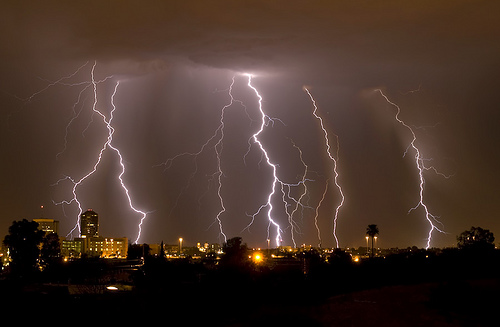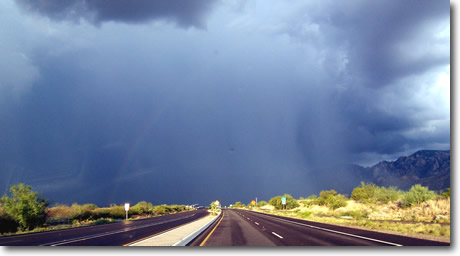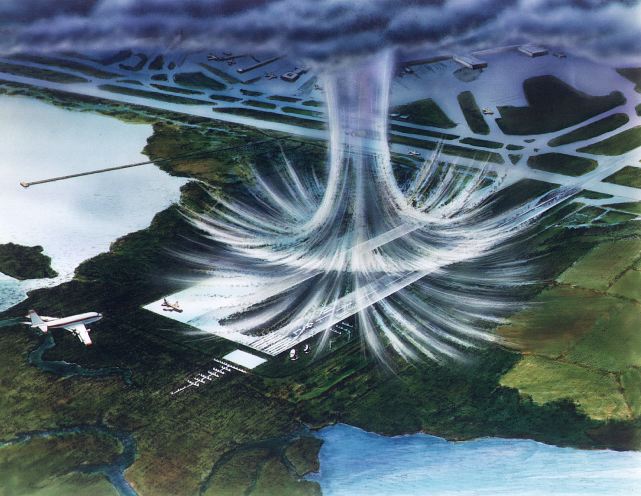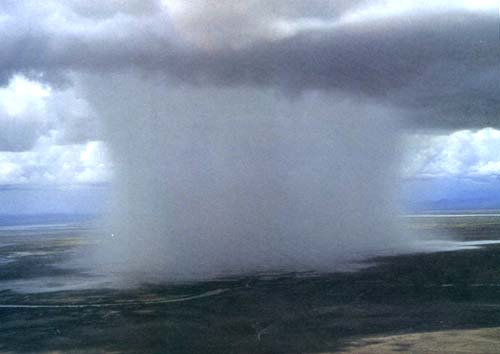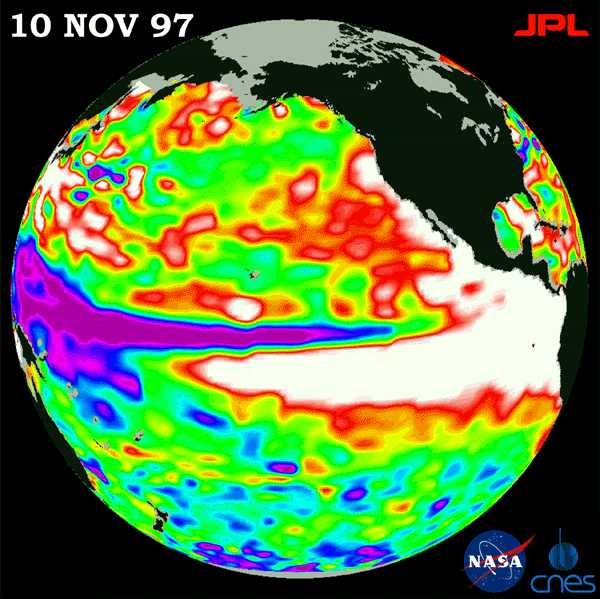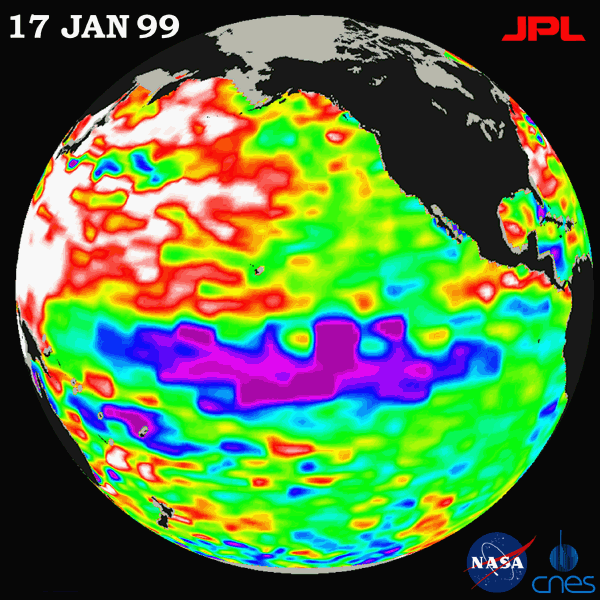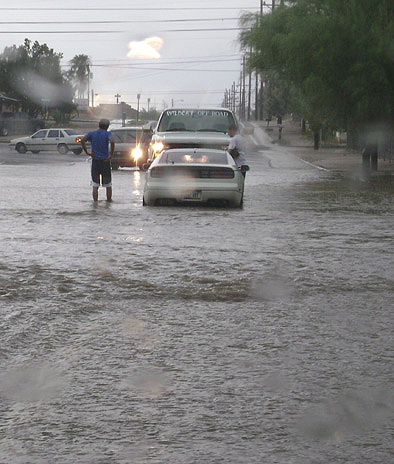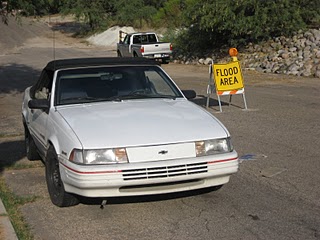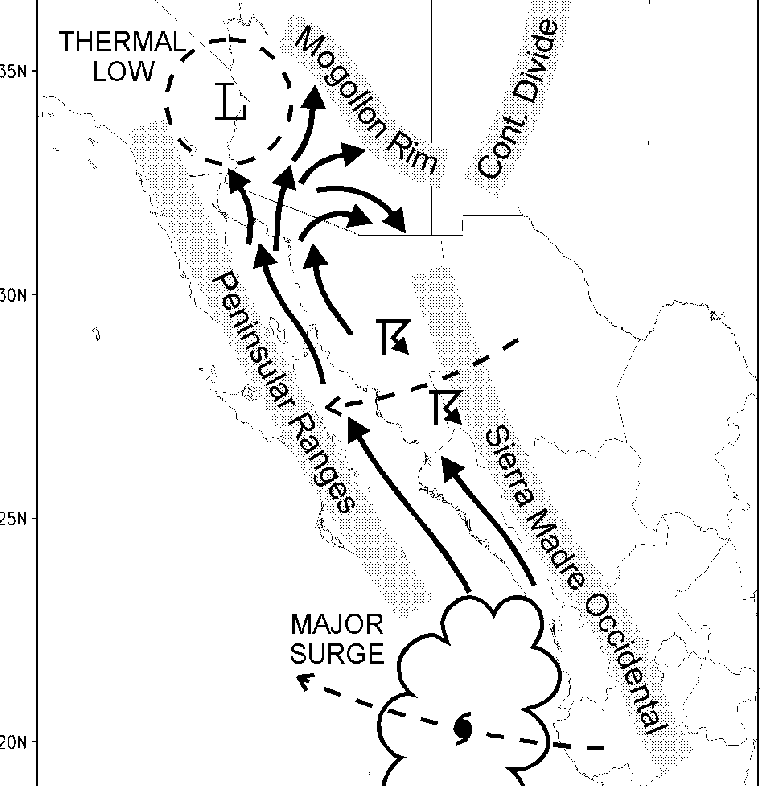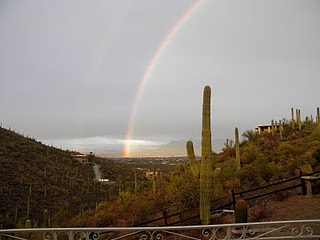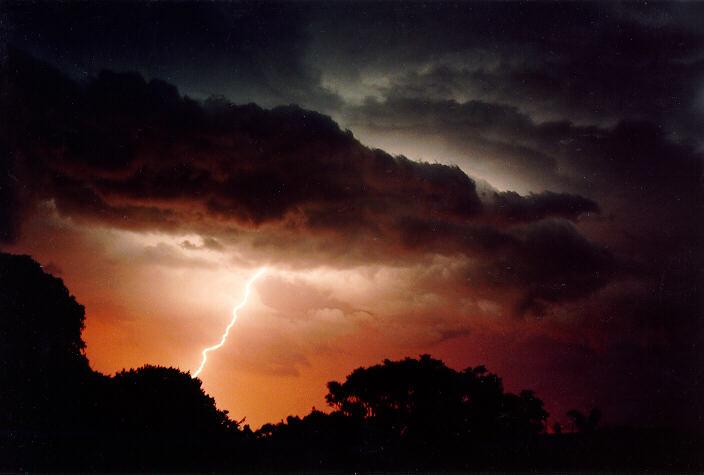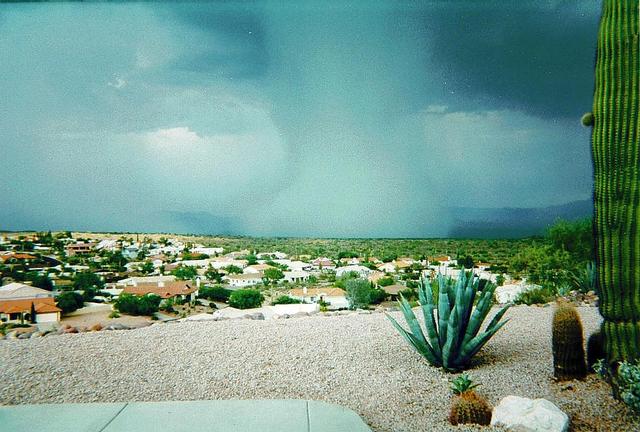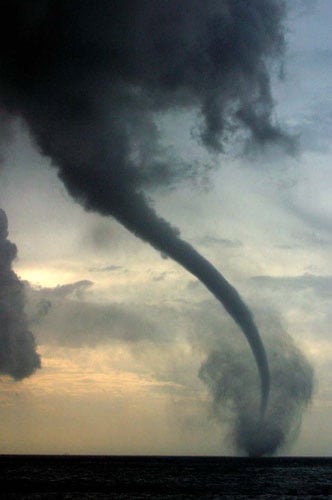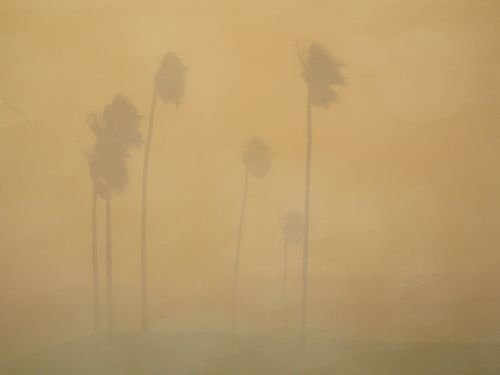First Alert Monsoon Need-to-know Quiz

This Monsoon Quiz will prepare you for the Monsoon! It will give you information on staying safe as well as on the science of the Southwest's unique season.
- 1.
How far, in miles, can lightning travel from the storm causing it?
- A.
5
- B.
1
- C.
10
- D.
20
- E.
16
Correct Answer
C. 10Explanation
Lightning can travel up to 10 miles from the storm causing it. This distance is known as the "flash range" and is the maximum distance at which lightning can strike the ground. Beyond this range, the electrical charge dissipates and the lightning is no longer a threat. Therefore, the correct answer is 10.Rate this question:
-
- 2.
How much rain, on a 30 year average basis, falls in Tucson during the Monsoon, in inches??
- A.
12
- B.
5
- C.
6
- D.
8
- E.
3
Correct Answer
C. 6Explanation
The correct answer is 6. This means that on average, Tucson receives 6 inches of rain during the Monsoon season over a period of 30 years.Rate this question:
-
- 3.
Which best describes a dry microburst?
- A.
The thunderstorm collapses quickly because there is little upper-level steering flow, resulting in the storm no longer being tilted. This lack of "tilt" makes the inflow and outflow (wind entering the storm and rain leaving the storm) directly on top of one another, thus killing the storm. The wind and rain then rush down to the ground and spread in all directions.
- B.
A storm's hail is too heavy, resulting in downward forces aking all of the storm's energy to the ground.
- C.
Rain falls into a dry layer of air. This rain evaporates in the dry air, which cools the air. Since cool air is heavy and dense, it rushes down to the ground and spreads in all directions.
Correct Answer
C. Rain falls into a dry layer of air. This rain evaporates in the dry air, which cools the air. Since cool air is heavy and dense, it rushes down to the ground and spreads in all directions.Explanation
A dry microburst occurs when rain falls into a dry layer of air. The rain evaporates in the dry air, causing the air to cool. As cool air is heavier and denser than warm air, it rapidly rushes down to the ground and spreads in all directions. This downward rush of cool air, combined with the spreading of rain, leads to the collapse of the thunderstorm. The lack of upper-level steering flow and the absence of tilt in the storm contribute to the direct alignment of inflow and outflow, further weakening the storm.Rate this question:
-
- 4.
Which best describes a wet microburst?
- A.
A storm's hail is too heavy, resulting in downward forces taking all of the storm's energy to the ground.
- B.
Rain falls into a dry layer of air. This rain evaporates in the dry air, which cools the air. Since cool air is heavy and dense, it rushes down to the ground and spreads in all directions.
- C.
The thunderstorm collapses quickly because there is little upper-level steering flow, resulting in the storm no longer being tilted. This lack of "tilt" makes the inflow and outflow (wind entering the storm and rain leaving the storm) directly on top of one another, thus killing the storm. The wind and rain then rush down to the ground and spread in all directions.
Correct Answer
C. The thunderstorm collapses quickly because there is little upper-level steering flow, resulting in the storm no longer being tilted. This lack of "tilt" makes the inflow and outflow (wind entering the storm and rain leaving the storm) directly on top of one another, thus killing the storm. The wind and rain then rush down to the ground and spread in all directions.Explanation
A wet microburst is described as a thunderstorm that collapses quickly due to the lack of upper-level steering flow, causing the storm to no longer be tilted. This lack of "tilt" leads to the inflow and outflow of wind and rain being directly on top of one another, which ultimately kills the storm. As a result, the wind and rain rush down to the ground and spread in all directions.Rate this question:
-
- 5.
What is El Niño? Choose the best description.
- A.
The warming of the tropical equatorial Pacific ocean above what it would normally be. It typically rears its head during the winter months. Fishermen off the coast of South America often must move northward to make large catches, following the cooler, more nutrient rich waters.
- B.
The cooling of the tropical equatorial Pacific ocean below what it would normally be.
- C.
Warmer than normal water gathering in the equatorial Pacific which causes above normal rainfall in the southwestern US during the winter and below normal rainfall in the Monsoon. It typically rears its head during the winter months. Fishermen off the coast of South America often must move northward to make large catches, following the cooler, more nutrient rich waters.
Correct Answer
C. Warmer than normal water gathering in the equatorial Pacific which causes above normal rainfall in the southwestern US during the winter and below normal rainfall in the Monsoon. It typically rears its head during the winter months. Fishermen off the coast of South America often must move northward to make large catches, following the cooler, more nutrient rich waters.Explanation
El Niño refers to the phenomenon of warmer than normal water gathering in the equatorial Pacific, resulting in above normal rainfall in the southwestern US during winter and below normal rainfall in the Monsoon. This phenomenon typically occurs during the winter months. As a result, fishermen off the coast of South America often have to move northward to find cooler and more nutrient-rich waters, where they can make larger catches.Rate this question:
-
- 6.
What is La Niña? Choose the most complete answer.
- A.
The cooling of the equatorial Pacific Ocean from South America westward. The Monsoon is often less active during La Niña.
- B.
Something that happens during solar storms resulting in more rainfall in North America.
- C.
The trade winds begin blowing more strongly from east to west from South America into the Pacific, upwelling cool water. This results in cooler-than-normal sea surface temperatures in the equatorial Pacific. The Monsoon is often enhanced by La Niña.
Correct Answer
C. The trade winds begin blowing more strongly from east to west from South America into the Pacific, upwelling cool water. This results in cooler-than-normal sea surface temperatures in the equatorial Pacific. The Monsoon is often enhanced by La Niña.Explanation
La Niña is a weather phenomenon characterized by the strengthening of trade winds blowing from east to west across the equatorial Pacific Ocean. These winds cause the upwelling of cool water, resulting in cooler-than-normal sea surface temperatures in the region. This cooling effect can have various impacts on global weather patterns, including the monsoon. During La Niña, the monsoon is often enhanced, leading to increased rainfall in certain regions.Rate this question:
-
- 7.
Which of the following is NOT a source for moisture during our Monsoon?
- A.
Gulf of Mexico
- B.
Pacific
- C.
Atlantic
- D.
Gulf of California/Sea of Cortez
- E.
Gulf of Alaska
Correct Answer
E. Gulf of AlaskaExplanation
The Gulf of Alaska is not a source for moisture during our Monsoon. Monsoons are characterized by the seasonal reversal of winds, which bring moist air from oceans to land, resulting in heavy rainfall. The Gulf of Alaska is located in the northeastern Pacific Ocean and does not contribute significantly to the monsoon system. The other options listed, such as the Gulf of Mexico, Pacific, Atlantic, and Gulf of California/Sea of Cortez, are all potential sources of moisture during the monsoon season.Rate this question:
-
- 8.
Which River runs generally east to west through the metro?
- A.
Rillito
- B.
Pantano
- C.
Santa Cruz
- D.
Cañada del Oro
- E.
Tanque Verde
Correct Answer
A. RillitoExplanation
The Rillito River runs generally east to west through the metro.Rate this question:
-
- 9.
PLEASE SELECT TWO ANSWERSWhich describes a natural progression of runoff through Tucson and even beyond (if applicable)? Two answers are correct. Only two answers represent logical drainage of rainfall runoff through and beyond the city.
- A.
Cañana del Oro to Tanque Verde to Pantano to Rillito
- B.
Tanque Verde to Rillito to Santa Cruz
- C.
Pantano to Tanque Verde to Santa Cruz
- D.
Santa Cruz to Rillito to Pantano
- E.
Pantano to Rillito to Santa Cruz to Gila
Correct Answer(s)
B. Tanque Verde to Rillito to Santa Cruz
E. Pantano to Rillito to Santa Cruz to Gila -
- 10.
How much water can push a full sized car off the road?
- A.
1 inch
- B.
6 inches
- C.
1 foot
- D.
3 feet
Correct Answer
B. 6 inchesExplanation
Even full sized cars with significant weight can be lifted off the ground by only 6 inches of water. Note: Water at night can be much deeper than it appears.Rate this question:
-
- 11.
Which group is more likely to be stuck by lightning *according to statistics
- A.
Men
- B.
Woman
Correct Answer
A. MenExplanation
Check this out: Of the 648 people killed by lightning in the U.S. from 1995 to 2008, 82 percent were male. So why does this happen? According to the experts, “Men take more risks in lightning storms,” says John Jensenius, a lightning safety expert with the National Weather Service.Rate this question:
-
- 12.
What is the name of the law which is suppose to prevent people from driving into washes by charging motorists for their rescue?
- A.
The Dumb Drivers Law
- B.
The Don't Drive in Washes Law
- C.
The Wash Rescue Law
- D.
The Stupid Motorists Law
Correct Answer
D. The Stupid Motorists LawExplanation
Law on the books in Arizona making the driver who IGNORES barricades and needs to be rescued to be charged a fine to pay for the rescue. As of June 1st 2010, no one has been charged under this law.Rate this question:
-
- 13.
The moisture from a "Gulf Surge" can be detected first in which city?
- A.
Yuma
- B.
Gila Bend
- C.
San Diego
- D.
Tucson
- E.
El Paso
Correct Answer
A. YumaExplanation
A Gulf Surge is moisture surging up the Gulf of California, usually this low-level moisture surge is detected first in the dew point readings in Yuma before spreading through the rest of ArizonaRate this question:
-
- 14.
From the bottom to the top of a rainbow, the colors are _________ to __________ and in the secondary rainbow from ________ to __________
- A.
Red to violet; red to violet
- B.
Violet to red; violet to red
- C.
Red to violet; violet to red
- D.
Violet to red; red to violet
- E.
Orange to purple; pink to yellow
Correct Answer
D. Violet to red; red to violetExplanation
The colors of the primary rainbow (or bottom rainbow) is from the violet to the red, but because a secondary rainbow is formed because of two reflections within a raindrop, it switches which color is on top for the second (or top) rainbow, so the colors are red to violet (and will appear more faint)Rate this question:
-
- 15.
Where is the ONLY safe place to be in a thunderstorm?
- A.
Under a tree
- B.
In an open air shelter (roof, but no walls)
- C.
Getting as low as possible in an open field
- D.
Inside a building (with four walls and a roof)
Correct Answer
D. Inside a building (with four walls and a roof)Explanation
Lightning can spread out in all directions, and just because you might be under a roof, lightning can actually travel sideways and hit you. Trees are tall and can attract lightning so NEVER stand under one during an electrical storm. A building or car are the only safe places during a thunderstorm. If you hear thunder, you are too close and must seek shelter. A car is also a safe place.Rate this question:
-
- 16.
How strong can wind be in a microburst?
- A.
20 MPH
- B.
80 MPH
- C.
110 MPH
- D.
170 MPH
Correct Answer
D. 170 MPHExplanation
microburst are reconized at generating wind speeds higher than 168 MPH.Rate this question:
-
- 17.
How many tornadoes are reported on average each year in Arizona? (not funnel clouds)
- A.
None
- B.
4
- C.
7
- D.
11
Correct Answer
B. 4Explanation
On average Arizona gets four tornadoes per year, however now that people are living in areas which were just open land before, reports of tornadoes could increase because more people are spread over a wider area.Rate this question:
-
- 18.
What do you do if you are driving and get caught in a dust storm while driving on the Freeway?
- A.
Pull over and take your foot off the break, turn off your lights, and make yourself invisible
- B.
Drive faster
- C.
Pull off to the side of the road with your blinkers engaged
- D.
Follow the person in front of you, make sure you don't loose them in the dust
Correct Answer
A. Pull over and take your foot off the break, turn off your lights, and make yourself invisibleExplanation
Dust storms can drop visibilities quickly. It is recomended by DPS to pull far off the side of the road, turn off your lights and take your foot off your break. If your lights are on, people could try and "follow you" and run into your parked car.Rate this question:
-
- 19.
Choose the most deadly, on average in the United States, of the following
- A.
Flooding
- B.
Lightning
- C.
Microbursts
- D.
Dust storms
Correct Answer
A. FloodingExplanation
Flooding is the most deadly, on average in the United States, among the given options. Flooding can cause significant damage to infrastructure, homes, and lives. It can lead to swift and powerful currents, submerging vehicles and causing drownings. Additionally, flooding can result in the destruction of buildings, contamination of water sources, and the spread of waterborne diseases. Flash floods, in particular, can occur with little warning, making them especially dangerous. The combination of these factors makes flooding the most deadly natural disaster in the United States.Rate this question:
-
Quiz Review Timeline +
Our quizzes are rigorously reviewed, monitored and continuously updated by our expert board to maintain accuracy, relevance, and timeliness.
-
Current Version
-
Mar 17, 2023Quiz Edited by
ProProfs Editorial Team -
Jun 02, 2010Quiz Created by
Koldnews13
 Back to top
Back to top



